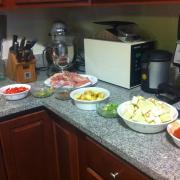Although they are not Azeri, my wife and her family lived in Bakı from the mid-1980s through the first half of the Nagorno-Karabakh war (my father-in-law, a Colonel in the Soviet Army, was stationed there). During that time my mother-in-law developed both an appreciation for and ability to cook Azerbaijani cuisine. One dish that became my wife's favorite is called "Азербайджанский соус" (Pronounced: /ˌæzərbaɪˈdʒɑːnskʲɪj sos/ Translit.: Azerbaidzhanskiy sous, English: Azerbaijani sauce). Sous, when pronounced by a Russian, sounds like the English word "so" with an "s" consonant added at the end. It is more of a stew than a sauce, at least in my mother-in-law's interpretation. The main ingredients include eggplant, peppers, tomato, cilantro, and a whole chicken. Given that my mother-in-law's rendition is so delicious, I wanted to learn how to reproduce it in my own kitchen. Having mastered the art of cookery through observation, my mother-in-law—like most other old world home cooks—is not a woman of weights and measures; her recipes are conveyed in units of "pinches of this" and "splashes of that." This makes reproducing a dish in foreign kitchens quite difficult. One of the problems with finding a formal, written recipe for Sous is that the same word has many other meanings in French with respect to gastronomy (e.g., "Sous-chef" and "Sous-vide"), which makes Google searches (even in Russian) ripe with false-positives. Furthermore, I can't seem to find any English-language recipes. For all of these reasons, I set out to grok my mother-in-law's method. I think I have converged upon a fairly stable recipe (with some of my own modifications) which I have outlined below. In doing so, I have tried to highlight the changes I have made to the original recipe.
Hardware
- 1 heavy bottomed pot, preferably a dutch oven.
- Paper towels.
- 1 colander.
Software
- Olive oil. Clarified butter (ghee) would be more traditional, though.
- 1 large eggplant, peeled and cut into 2cm cubes.
- Kosher salt.
- 1 whole chicken, 1.5–2 kg., broken down into breasts (halved; kitchen shears work well for this), thighs, drumsticks, wings (halved at the joint), neck and back bone. My mother-in-law doesn't remember if the Azeris traditionally skin the chicken first, but she does, and I tend to agree; given that the chicken will essentially be braised, any skin would just end up being rubbery. I don't skin the wings, though, because that is a pain. Also, I would recommend brining the chicken since both the white and dark chicken meat will be cooked for equal periods. If that requires too much time/effort, you can simply buy Kosher or Halal chicken (which, by virtue of their processing, are essentially brined).
- 1 large onion, diced.
- 1 large red bell pepper, diced.
-
1 large clove of garlic, grated. My mother-in-law doesn't use this.
Garlicks, tho' used by the French, are better adapted to the uses of medicine than cookery.
—''American Cookery'' (1796) by Amelia Simmons - 1 tsp. dried, powdered turmeric. My mother-in-law doesn't use this, and I am not sure if it is traditional in sous. My Iranian Ph.D. advisor tells me that, in Persian cooking (which, neighboring Azerbaijan, is somewhat similar), turmeric is always added to onions when they are cooked.
- ~1/2 kg. potatoes (preferably red waxy potatoes, but Yukon Gold will also work), cut into 2cm cubes or wedges, equal to about 6 medium potatoes. My mother-in-law rinses the cut potatoes to remove some of their starch; I don't think this is necessary, as the small bit of starch will help thicken the stew.
- 2 large, ripe tomatoes, sliced into 5mm thick discs. Preferably skinned, but that is not critical. Roma would be a good variety, but they tend to be small so you will need more like three or four. Alternatively, I've found that you can use one 14oz. can of diced tomatoes (drained), but it would not be traditional.
- 1/3 cup cilantro, roughly chopped.
- 1 tbsp. dill, chopped.
Algorithm
Note: My mother-in-law cooks all of the ingredients separately, in separate pans, before layering everything together in the large pot for stewing/braising. While this technique may be traditional, I don't really understand its purpose. In addition to the fact that cooking everything in a single pot makes cleanup much easier, all of the fond that accumulates on the bottom of the pot remains in the stew, adding flavor from the Maillard reactions. Therefore, I just cook everything in a single enameled, cast iron dutch oven.
- Liberally salt the cubed eggplant and set aside.
- Put the dutch oven over medium-high heat and add enough fat (oil/ghee) to coat the bottom (about 1 tbsp.)
- Dry the chicken completely with paper towels. This is a lot easier if you do not wash your meat.
- Salt the chicken. If you are not using brined/treated/Kosher/Halal chicken, you will need to use a lot more salt.
- When the oil is shimmering, add the chicken. You will probably need to do the chicken in batches; you do not want to overcrowd the pan. Brown the chicken, about 1 minute on each side. Evacuate the chicken to a plate or bowl after it has browned. Add extra fat between batches, if needed.
- If there is a lot of fat in the pot, remove and reserve the excess such that there is only enough remaining to coat the bottom (about 1 tbsp.).
- Lower the heat to medium and add the onion. Sweat until the onion turns translucent, about 5 minutes.
- Add the red pepper. Sweat for another 5 minutes.
- Optionally add the garlicks and/or turmeric and cook until fragrant, about 30 seconds. If you want more of an Indian flavor you can also add fresh grated ginger, a teaspoon of garam masala, and a quarter teaspoon each of ground cumin, coriander, and cardamom.
- Reduce heat to medium-low (or "simmer" if your range has that setting), and add the potato in an even layer over the aromatics. (See the note below for a modification that adds the eggplant before the potato.)
- Add the browned chicken, along with any accumulated juices. Try and place the chicken in an even layer on top of the potato.
- Place the eggplant in the colander and rinse to remove salt.
- Add the eggplant in an even layer on top of the chicken.
- Add the tomato on top of the eggplant.
- Pour a tablespoon or two of the reserved oil (or olive oil, if there was no excess after searing the chicken) over everything. This is not traditional, however, my mother-in-law pan fries the eggplant before adding, so adding oil now accounts for the oil that the eggplant would have absorbed if it would have been fried.
- Cover and cook, remaining on medium-low heat, until the eggplant has released its liquid, about 20 minutes.
- Once there is enough liquid to cover the chicken, push the meat down such that it is all submerged. Bring the liquid back to a simmer, cover, and cook for an additional 45 minutes, stirring once every 15 minutes.
- Add cilantro and dill.
- Taste some.
- Think.
- Adjust seasoning.
- Eat.
Note: If I were devising this recipe, I would have layered the eggplant below the chicken. I have been told by the experts (i.e., my wife and her mother) that it would ruin everything, but I couldn't imagine how! I have tried adding the eggplant to the onion and peppers and cooked them for a few minutes before layering on the potatoes, and it has worked very well, decreasing the amount of time required for enough liquid to accumulate to submerge the chicken. I highly recommend trying that.
 PoC‖GTFO
PoC‖GTFO Twitter
Twitter LinkedIn
LinkedIn GitHub
GitHub XTerm
XTerm
 Esperanto
Esperanto
 עברית
עברית
 Medžuslovjansky
Medžuslovjansky
 Русский
Русский



